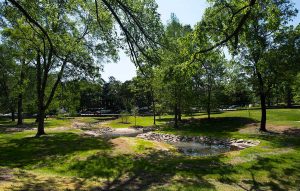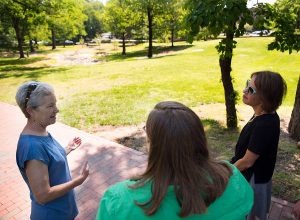The gentle stream that flows beside McIver Residence Hall from Raleigh Street to Country Club Road hasn’t always been part of the campus landscape. It just looks as though it has.
A pipe beneath the street and the natural path of water, both rainwater and the springs that originate above Coker Arboretum and make their way to the far side of Forest Theatre, presented an opportunity for staff in Finance and Administration to collaborate on a unique solution for the perpetually wet field near McIver.

Chapel Hill, NC. April 26, 2016.
(Jon Gardiner/UNC-Chapel Hill)
Instead of simply repairing and reburying the entire pipe, Sally Hoyt, stormwater engineer in Energy Services, and Jill Coleman, landscape architect in Facilities, worked with a team of consultants and University staff to create a lovely aboveground stream with a filtration process that will naturally filter pollutants and contaminants out of runoff water. The new stream benefits the quality of the water downstream as well as in the immediate area.
The University has been working to improve stormwater runoff and overall water quality since work on the campus development plan began in 1998 and a master plan was developed a few years later, Coleman said. The Battle Grove Restoration Project is part of that ongoing effort and one aspect of the new Three Zeros Initiative that aims to accomplish carbon neutrality by 2050, send zero waste to landfills and achieve net zero water use. That campus-wide initiative will officially launch in the fall.
“We’ve studied multiple restoration sites,” Hoyt said, “and the field by McIver is the only place on campus we could daylight water – that is, take it out of the pipe and turn it into a stream.”
The concept is a working landscape, one that achieves a specific utilitarian purpose in addition to being attractive.

Chapel Hill, NC. April 26, 2016.
(Jon Gardiner/UNC-Chapel Hill)
“The Grounds Department staff told us they had difficulty mowing grass on that site because it stays so wet,” Hoyt said, “so that gave us the idea to create a more sustainable way for the water to flow. What we devised is really a hybrid between a natural stream and a wetland area.”
How the water flows is key, Coleman explained. Heavy rains can cause erosion and sedimentation, so slowing the movement of the water across rocks and through sand and wetland plants acts as a filter to clean the water, she said. Ultimately, that has a positive effect far downstream as the water continues to flow to the state’s rivers and eventually to the seafood-producing sounds.
“What’s wonderful about this project is that it has allowed us to build a beautiful riparian landscape around a meandering historic stream in a gorgeous place on campus and service our water,” Chancellor Carol L. Folt said when she toured the Battle Grove Restoration Project on April 27. “It just brings together our science, our technology, our energy services, our facilities management and open space in a really exciting way.” (See more about Folt’s tour.)
The project is a work in progress. As the Grounds Department adds plants that thrive in that microclimate, Hoyt’s group will continue to assess the water flow, so together, they can fine-tune the look and function of the stream.
Anticipating potential issues is part of that process. For example, the natural habitat Hoyt and Coleman are creating is designed to attract insects, both beautiful and bothersome. In the long run, natural predators will control the bothersome ones like mosquitoes, and in the short term, the area will be monitored to ensure that it doesn’t become a mosquito breeding ground.
“This project really changes the character of the place and attracts people to it,” Coleman said. “We will continue to watch and adapt, and a year from now it’s possible that the area will look different than it does today.”
To fund the $362,439 project, Hoyt leveraged a grant she secured from the N.C. Division of Environmental Quality with campus stormwater utility fees. “We hope to be doing more projects like this in the future,” she said.
Across campus, another innovative stormwater project was completed in 2012 when the area surrounding the Bell Tower was transformed from a parking lot into a small amphitheater. There, University staff worked with consultants to develop an integrated, non-potable water system based on a comprehensive water management strategy.
Rainwater that falls on the roof of the nearby Genome Sciences Building drains into a lined, stone-filled cistern beneath the Bell Tower Amphitheater. Following UV treatment and chlorination, water in the cistern, which can hold up to 350,000 gallons, is used to flush 1,000 toilets in the Genome Sciences Building and to irrigate the landscaping around the building as well as the field in Kenan Stadium. If there is not sufficient rainwater to do this, reclaimed water provided by Orange Water and Sewer Authority in an adjacent system is available as a backup water source.
In addition, concrete vaults store ground-level stormwater on a short-term basis, reducing downstream erosion, flooding and pollutant levels.
The Bell Tower Amphitheater project is the University’s largest stormwater project to date in terms of the volume of water handled, Coleman said, but it isn’t the only project designed to collect and channel water. For example, rainwater collected in renovated underground cisterns at Hooker Field is used to irrigate Fetzer Field and the football practice field.
Assessment is key. Hoyt and her colleagues in Energy Services work hand in hand with the Sustainability Office; Environment, Health and Safety; and the Grounds Department to assess the effectiveness of the various water management projects. Staff members examine key areas, comparing current results against the baseline assessment conducted in 2001-02, to see how campus development is affecting water quality and stormwater runoff, Hoyt said.
“We project the benefits to a certain area based on models,” she said, “and we revisit those areas to make sure what we have designed works as it was intended.”
